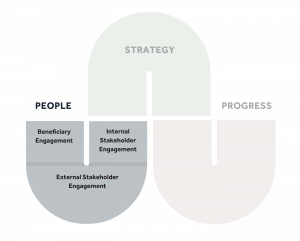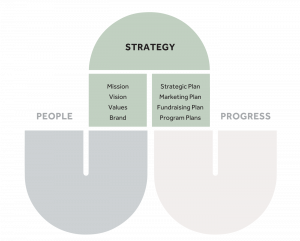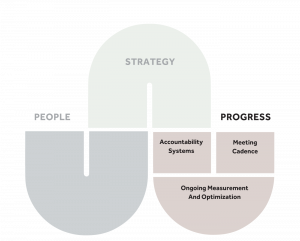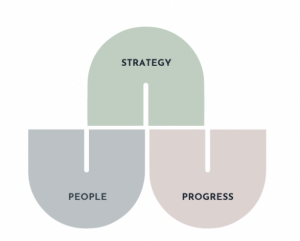What is the Nonprofit Strategy System?
Based on a wide body of research about what makes some nonprofits succeed while others struggle, as well as our real-world experience with hundreds of organizations of all shapes and sizes, the Nonprofit Strategy System provides a practical, actionable method for achieving the organizational effectiveness you have always dreamed of.
You can use the system to bring together the three elements every nonprofit must synergiez in order to achieve its full potential: People, Strategy, and Progress. We also use the system to ensure every project we work on properly involves stakeholders, puts emphasis on developing effective and inclusive strategies, and concludes by giving our clients the tools they need to bring those strategies to life. Learn more below and begin using the Nonprofit Strategy System today.
Why is the Nonprofit Strategy System important?
The challenges facing our planet, our communities, and our families are significant. Our planet has lost half its wildlife in the last 50 years. Ten percent of the world’s population still lives in extreme poverty. Hunger has been on the rise globally since 2015. Here in America, Black and Latinx students continue to see fewer opportunities for educational advancement. Economic inequality continues to grow. Death from gun violence has reached its highest rate in over two decades.
Every day, nonprofits are taking meaningful action to combat these problems, but organizations face obstacles that hold them back from doing all they could to truly make an impact. In fact, most nonprofit CEOs report that producing results continues to get more and more challenging, and 30% of nonprofits fail within 10 years. Demand is growing, resources are shrinking, competition is fierce, trust in nonprofits is declining, and the nonprofit starvation cycle is accelerating as funders and supporters continue to look to the wrong metrics – like overhead ratios – to determine nonprofit effectiveness.
These challenges are substantial, and to overcome them, nonprofits need a proven, equitable method for increasing their effectiveness and impact.
The Nonprofit Strategy System is the answer.
How Does the Nonprofit Strategy System work?
Here’s what each component involves:
People
 People are at the heart of The Nonprofit Strategy System because it is based on our Shared Power Strategy philosophy, which says that in order to be truly effective and equitable, your nonprofit must share the power to shape its strategy with its many diverse stakeholders. That means thoughtfully including your beneficiaries, clients, donors, volunteers, funders, staff, affiliates and community members (and others) in providing input and insights that will inform your strategic plan, marketing plan, brand strategy or fundraising plan. It also means asking them for frequent feedback, and actually listening.
People are at the heart of The Nonprofit Strategy System because it is based on our Shared Power Strategy philosophy, which says that in order to be truly effective and equitable, your nonprofit must share the power to shape its strategy with its many diverse stakeholders. That means thoughtfully including your beneficiaries, clients, donors, volunteers, funders, staff, affiliates and community members (and others) in providing input and insights that will inform your strategic plan, marketing plan, brand strategy or fundraising plan. It also means asking them for frequent feedback, and actually listening.
If your organization wishes to leverage the power of the Nonprofit Strategy System, you must begin by conducting a comprehensive audit of your stakeholders and determining how best to involve them in shaping your strategy. Options can include everything from basic surveys to intensive stakeholder advisory committees. For organizations with a wide range of stakeholders (most nonprofits) and those who work with groups like youth, people living with disabilities or those experiencing trauma, stakeholder engagement can be extremely challenging and complex. But that’s precisely why it’s so important.
Strategy
 Every effective nonprofit is built on a foundation of the following strategic elements, which you should develop based on input from your stakeholders:
Every effective nonprofit is built on a foundation of the following strategic elements, which you should develop based on input from your stakeholders:
A vision statement that describes the future you would create if your organization achieved all its goals
A mission statement that describes the work you are doing every day to drive toward your vision – what you do, who you do it for, and the intended impact
A vision statement that describes the future you would create if your organization achieved all its goals
Values that act as guiding principles, shaping the behavior and decision making of everyone on a nonprofit’s team
A brand that includes the messaging you use to talk about your organization and the visual identity that makes it recognizable to those you need to reach
With that strong foundation in place, you should then work with your stakeholders to shape the following types of strategies for your organization, which will guide your day-to-day work and ensure your impact over the long-term:
A strategic plan for your entire organization that determines how you will pursue your mission over the next ~3 years and focuses the efforts of everyone on your team around clear objectives and key results.
A marketing and communications plan that determines how your organization will raise awareness, foster engagement and activate stakeholders in service of the objectives in its strategic plan.
A fundraising and development plan that determines how your organization will strengthen existing funding sources and develop new ones in service of the objectives in its strategic plan.
Program and service plans that detail how each key program or service that makes up your organization will contribute to the objectives in your nonprofit’s strategic plan.
Progress
 The lynchpin of the Nonprofit Strategy System is the Progress element. Even with effective stakeholder engagement and smart strategies in place, it can be hard to get everyone on your team to take consistent, coordinated action to advance your mission. The Progress element solves this problem by building a culture of accountability and putting processes in place that keep everyone on track and ensure you’re regularly optimizing your work based on what you’re learning. This includes:
The lynchpin of the Nonprofit Strategy System is the Progress element. Even with effective stakeholder engagement and smart strategies in place, it can be hard to get everyone on your team to take consistent, coordinated action to advance your mission. The Progress element solves this problem by building a culture of accountability and putting processes in place that keep everyone on track and ensure you’re regularly optimizing your work based on what you’re learning. This includes:
Accountability systems such as key results for each objective in your plan, activity plans that lay out exactly who must do what for the next 12 months in accordance with your strategies.
A meeting cadence that helps you bring the right people together monthly, quarterly and annually to move your strategy forward, assess progress and make adjustments.
Ongoing measurement optimization practices centered around an objective and key results (OKRs) dashboard that helps you understand what’s working, what’s not and how to optimize your strategy accordingly, for the good of the people and communities you serve.
Outcomes
Organizations that implement the full Nonprofit Strategy System can say the following…
- We have deeply and authentically involved our diverse range of stakeholders in shaping our organization’s strategy, while putting significant emphasis on the people and communities we serve.
- We have a vision and mission statement that accurately communicates why we exist, and it has been properly communicated to all staff, board members, and external stakeholders.
- Our core values are clear – we are hiring, reviewing, rewarding and firing around them. They guide our decision making.
- Our messaging and identity reflect our mission, vision and values.
- We have a strategic plan that is based on the priorities of our stakeholders, updated yearly and optimized quarterly.
- Programs/services, marketing/communications and development/fundraising each have their own strategies and plans that have been developed in direct response to our organization’s strategic plan.
- Our strategic plan is shared externally and we report on progress against it to our stakeholders regularly, while asking for their feedback.
- Internally, everyone has access to the organization’s strategies and knows who is responsible for what.
- Our talent reflects the diversity of the people and communities we serve, and our work environment emphasizes inclusion and equity for everyone on our team
- Everyone on our team is engaged in regular meetings to move our strategies forward.
- We have a system for receiving regular input from all our stakeholders.
- We know what success looks like and use clear metrics to define it.
- We have a dashboard for tracking financial performance, goal progress and outcomes against metrics.
- We have clear objectives and key results that we measure against regularly.
- We are agile. While we stick to our strategies, we also know when to make adjustments and do so for the right reasons – to work smarter in service of our mission.
